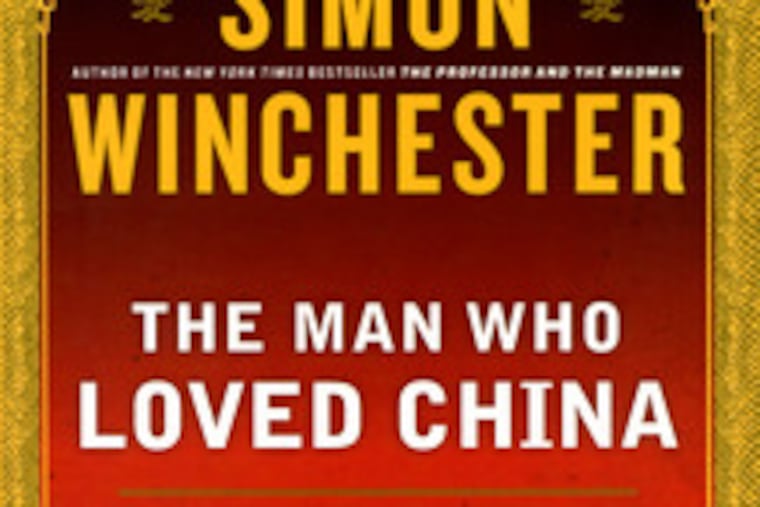An English don's eccentric passion
Joseph Needham's love for a woman led him to write volumes on the ingenuity of the Chinese.

The Fantastic Story of the Eccentric Scientist Who Unlocked the Mysteries
of the Middle Kingdom
By Simon Winchester
Harper Collins. 316 pp. $27.95
Reviewed by Charles Desnoyers
It has long been a source of wonderment among China specialists that Joseph Needham's
Science and Civilization in China
was produced by a man without formal training in Chinese studies or the history of science.
Perhaps equally remarkable is that it came about through love: Needham's discovery of China at age 37 was the product of his affair with fellow biochemist Lu Gwei-djen, whom he ultimately married at 89 following the death of his wife, Dorothy.
Needham's masterpiece, which reached 17 volumes by the time of his death, is "universally acknowledged to be the greatest work of explanation of the Middle Kingdom that has yet been created in Western history," writes Simon Winchester.
As he so ably did in
The Professor and the Madman
, Winchester strips away the donnish placidity of English university life in
The Man Who Loved China
to reveal a remarkable set of characters, none more so than Needham himself.
A polymath blessed with a photographic memory, Needham by age 24 had been named a Cambridge Fellow for his work in embryology. An equally devout Anglican and Darwinist, he was an ardent socialist, a devotee of morris dancing and nudism, and along with Dorothy - herself a noted expert on muscle biochemistry - a determined flouter of bourgeois sexual convention.
But it was Lu Gwei-djen who, during her research stay at Cambridge, became Needham's muse. As their affair blossomed with Dorothy's acquiescence, she began to teach him Chinese. Through his immersion in this wholly "other" language, Needham became totally infatuated with the people who created it.
By the early 1940s, Needham was considered expert enough for the British government to send him on a mission to contact and assist scientists scattered throughout a China desperately resisting Japanese invasion.
Needham's position as a British representative and leading scientist gave him entrée to such leading Chinese figures as Chiang Kai-shek and Chou En-lai, as well as New Zealander Rewi Alley, a fellow eccentric and "friend of China."
It was during these trips into some of China's most remote and dangerous back country that Needham's initial conception for
Science and Civilization
gelled.
His appetite for investigating China's ancient technical accomplishments had long since been whetted, and he used his government appointment to gather immense amounts of documents and artifacts.
Such a project was sorely needed, he believed. Although visitors from Marco Polo onward had touted China's wonders, the Enlightenment and the Industrial Revolution had propelled the West into a position of such dominance that it cemented an impression of China as "unchanging" and hopelessly backward.
As Ralph Waldo Emerson famously put it, China was a "booby nation" characterized by "reverend dullness," and at "the convocation of nations" could only say, "I made the tea."
Needham, however, knew better. His scientific predecessor, Francis Bacon, had noted in the 17th century that the three most important inventions of his world were printing, the compass and gunpowder, all of which, though he did not realize it, were Chinese breakthroughs. Some, like printing, were developed many centuries before they were in the West.
With a subtle wink at his readers, Winchester makes this point by reproducing the opening of the
Diamond Sutra
- to date, the world's oldest known printed book - on the inside covers of
The Man Who Loved China.
It was the sheer volume and high rate of innovation that most impressed Needham: earthquake detectors, mechanical clocks, porcelain, cast and wrought iron, the use of coal and natural gas, map grids, chain pumps, horse collars, moldboard plows, wheelbarrows, stern-post rudders, water-tight compartments, torpedoes and bombs, and paper money.
For 15 centuries, from the Han to the Ming Dynasties, Needham calculated that the Chinese came up with no less than 15 major inventions or scientific breakthroughs per century, a rate surpassing even the Greeks by a wide margin.
Yet he also noticed a curious anomaly: around the year 1500, the pace of innovation dropped off precipitously and never really recovered. While on his mission in China he penned a random note to himself on this point that grew into what became known as "the Needham Question":
Having led the world in innovation for thousands of years, why did modern science develop not in China but in Europe after 1500?
Needham would labor from the late 1940s until his death in 1995 to answer this question and to place China's accomplishments in world perspective.
Such is his legacy that new volumes are still being added to the
Science and Civilization
series by other scholars through the Joseph Needham Research Institute in Cambridge, England. The project now runs 24 volumes, 15,000 pages and about three million words.
This is a wonderfully entertaining book. While specialists may find its finer technical points a bit thin in places, and American readers might puzzle over its occasional "Britishisms," Winchester deftly probes the nexus of the public and private facets of one of scholarship's most profound minds and eccentric personalities.
Few biographers have had better material or so skillfully given it its due.